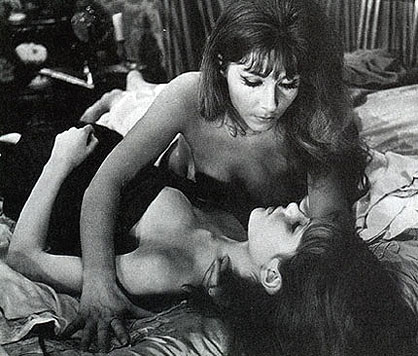Once upon a time, vampires were resurrected corpses: ghastly, smelly creatures that crawled back out of their graves and attacked innocent victims with all the seductive charm of ravenous predators, hungry only for the living blood that would warm their cold flesh and sustain their undead existence. Much has changed over the centuries. In literature and cinema, the undead have morphed from mindless blood-drinkers to sophisticated aristocrats to Byronic anti-heroes to misunderstood outsiders; through it all, their sexual charisma has been increasingly emphasized to the point where (as in the recently released TWLIGHT) they are no longer monsters but objects of affection. As with man “innovations,” the audience watching TWLIGHT probably thinks they are seeing something new, but hot-blooded passionate vampires have been around since the dawn of talking films. Below is a rogue’s gallery of the most memorable.
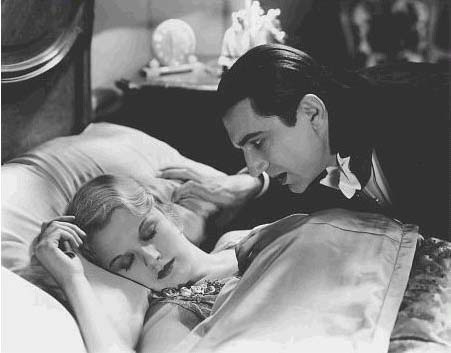 Bela Lugosi as the Count in DRACULA (1931). Lugosi was cinema’s first seductive vampire. Hungarian by birth, the actor exuded Continental charm of the sort guaranteed to leave your average American male feeling inadequate and jealous by comparison. All he had to do was deliver a few lines of dialogue in his mesmerizing cadence, and Lucy Western (Frances Dade) was smitten, dreaming of Castle Dracula in Transylvania. Of course, nothing overtly sexual could be shown in 1931, but that is part of the cinematic appeal of vampirism, with blood-drinking standing in symbolically for other exchanges of bodily fluids. The Count could sneak into a woman’s bedroom – practically into her bed – and in a case of mass denial, audiences and critics could pretend they were watching a horror scene when it was actually ravishment.
Bela Lugosi as the Count in DRACULA (1931). Lugosi was cinema’s first seductive vampire. Hungarian by birth, the actor exuded Continental charm of the sort guaranteed to leave your average American male feeling inadequate and jealous by comparison. All he had to do was deliver a few lines of dialogue in his mesmerizing cadence, and Lucy Western (Frances Dade) was smitten, dreaming of Castle Dracula in Transylvania. Of course, nothing overtly sexual could be shown in 1931, but that is part of the cinematic appeal of vampirism, with blood-drinking standing in symbolically for other exchanges of bodily fluids. The Count could sneak into a woman’s bedroom – practically into her bed – and in a case of mass denial, audiences and critics could pretend they were watching a horror scene when it was actually ravishment.
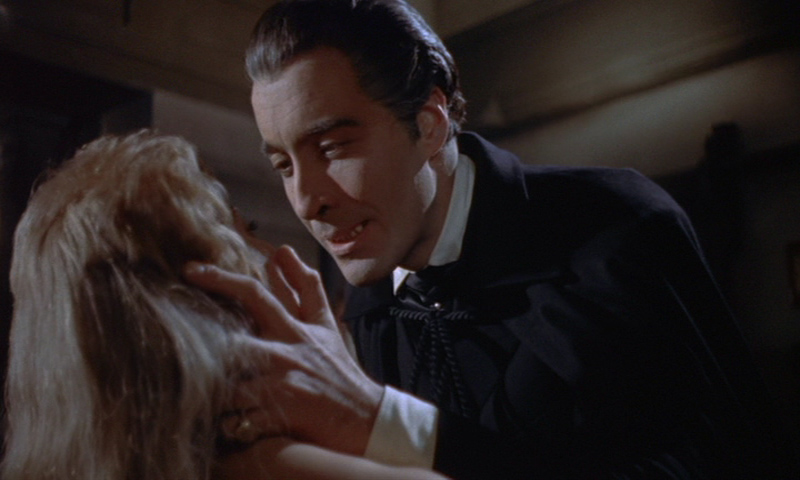 Christopher Lee as the Count in HORROR OF DRACULA (1958). Twenty-seven years after Lugosi, Christopher Lee redefined the Vampire King in much more physical terms. Gone was the oily charm and much of the mesmeric quality; this Dracula’s advances upon women were much more aggressive and overtly carnal, suggesting an undead rapist from beyond the grave. (True to the fantasy – not the reality – of rape, the women eventually succumb willingly, even if they are ambivalent or reluctant at first.) Lee played the role many times after HORROR OF DRACULA; although the sequels often failed to use the Count in interesting ways, the actor always maintained the not so subtle sexual subtext that made his vampire alluring even while he was dangerous.
Christopher Lee as the Count in HORROR OF DRACULA (1958). Twenty-seven years after Lugosi, Christopher Lee redefined the Vampire King in much more physical terms. Gone was the oily charm and much of the mesmeric quality; this Dracula’s advances upon women were much more aggressive and overtly carnal, suggesting an undead rapist from beyond the grave. (True to the fantasy – not the reality – of rape, the women eventually succumb willingly, even if they are ambivalent or reluctant at first.) Lee played the role many times after HORROR OF DRACULA; although the sequels often failed to use the Count in interesting ways, the actor always maintained the not so subtle sexual subtext that made his vampire alluring even while he was dangerous.
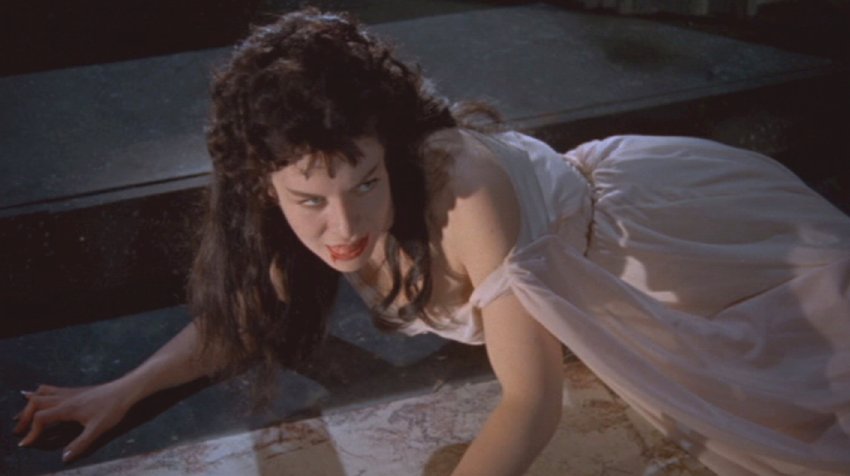 Valerie Gaunt as the Vampire Woman in HORROR OF DRACULA. Female vampires of an earlier era tended to be more sedate and slow-moving. Gaunt’s unnamed vampiress, although briefly seen, was a memorably breath-taking change-of-pace. Buxom and beautiful, she befriends Jonathan Harker by pretending to need his help, then sinks his fangs into him unexpectedly. Her fierce, predatory nature and good looks set the style for numerous female vampires over the next decade: beautiful fatal women whose charms were so alluring that men might willing lose their lives to them.
Valerie Gaunt as the Vampire Woman in HORROR OF DRACULA. Female vampires of an earlier era tended to be more sedate and slow-moving. Gaunt’s unnamed vampiress, although briefly seen, was a memorably breath-taking change-of-pace. Buxom and beautiful, she befriends Jonathan Harker by pretending to need his help, then sinks his fangs into him unexpectedly. Her fierce, predatory nature and good looks set the style for numerous female vampires over the next decade: beautiful fatal women whose charms were so alluring that men might willing lose their lives to them.
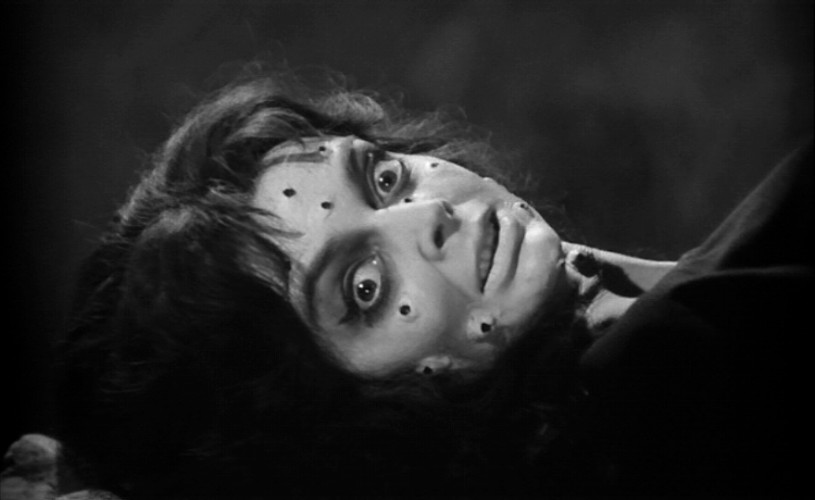 Barbara Steele as Princess Asa in BLACK SUNDAY (a.k.a. THE MASK OF SATAN, 1960). Princess Asa was not the first female vampire to play a lead role (that honor goes to DRACULA’S DAUGHTER in 1936), but she is the first one who is truly hot, thanks in no small part to the performance of actress Barbara Steele, who makes the resurrected revenant desirability almost palpable. Burned as a witch, Asa revives centuries later. Still unable to move, she succeeds in luring her first victim to her side using only her seductive charms, most prominently her heaving chest as she lies otherwise immobile on her slab, lusting for the blood that will infuse her with new life. There is a kind of sick almost sadomasochistic edge to this particularly vampire, thanks to her pockmarked face (result of her torture and execution that killed her), and having her literally kiss her victim will still lying in her tomb lends a creepy shudder at the necrophiliac undertones. Thanks to Steele, it is easy to believe that her victim would be swept away by desire and ignore these disturbing undertones.
Barbara Steele as Princess Asa in BLACK SUNDAY (a.k.a. THE MASK OF SATAN, 1960). Princess Asa was not the first female vampire to play a lead role (that honor goes to DRACULA’S DAUGHTER in 1936), but she is the first one who is truly hot, thanks in no small part to the performance of actress Barbara Steele, who makes the resurrected revenant desirability almost palpable. Burned as a witch, Asa revives centuries later. Still unable to move, she succeeds in luring her first victim to her side using only her seductive charms, most prominently her heaving chest as she lies otherwise immobile on her slab, lusting for the blood that will infuse her with new life. There is a kind of sick almost sadomasochistic edge to this particularly vampire, thanks to her pockmarked face (result of her torture and execution that killed her), and having her literally kiss her victim will still lying in her tomb lends a creepy shudder at the necrophiliac undertones. Thanks to Steele, it is easy to believe that her victim would be swept away by desire and ignore these disturbing undertones.
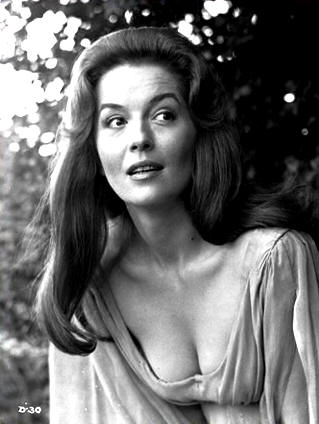 Barbara Shelley in DRACULA, PRINCES OF DARKNESS (1965). In this sequel to HORROR OF DRACULA, Shelley plays a vampire in the model of Valerie Gaunt, but there is a twist: she starts out as a prim Victorian wife before transforming into an infernal seductress. The switch is starling, suggesting that the character’s repressive attitudes were a way of restraining her own hidden desires, which explode free when she becomes a vampire. These desires turn out to be lesbian in nature; she shows no interest in potential male victims, focusing her attentions instead upon her sister-in-law. Shelley was one of the best actresses to play this kind of role: she brings something more to the role than mere good looks – a real sense of hot hidden passions finally boiling to the surface.
Barbara Shelley in DRACULA, PRINCES OF DARKNESS (1965). In this sequel to HORROR OF DRACULA, Shelley plays a vampire in the model of Valerie Gaunt, but there is a twist: she starts out as a prim Victorian wife before transforming into an infernal seductress. The switch is starling, suggesting that the character’s repressive attitudes were a way of restraining her own hidden desires, which explode free when she becomes a vampire. These desires turn out to be lesbian in nature; she shows no interest in potential male victims, focusing her attentions instead upon her sister-in-law. Shelley was one of the best actresses to play this kind of role: she brings something more to the role than mere good looks – a real sense of hot hidden passions finally boiling to the surface.
 Jonathan Frid as Barnabas Collins in DARK SHADOWS (1960s soap opera). Frid played Barnabas as a tragic character, cursed with desires he abhored but could not control. In keeping with the soap opera nature of the show, love stories and romantic entanglements were a big part of the plot lines. In particularly, the 100-year-old vampire yearned for his lost love from the time when he was human; conveniently, she was reincarnated (a plot line that would be resued in BRAM STOKER’S DRACULA). Though Barnabas was a reluctant vampire, his approach to women maintained a seductive aura that was enhanced by his tragic nature; the combination appealed to millions of female fans when the show originally aired. Barnabas Collins may be the screen’s first truly Romantic member of the legion of the undead.
Jonathan Frid as Barnabas Collins in DARK SHADOWS (1960s soap opera). Frid played Barnabas as a tragic character, cursed with desires he abhored but could not control. In keeping with the soap opera nature of the show, love stories and romantic entanglements were a big part of the plot lines. In particularly, the 100-year-old vampire yearned for his lost love from the time when he was human; conveniently, she was reincarnated (a plot line that would be resued in BRAM STOKER’S DRACULA). Though Barnabas was a reluctant vampire, his approach to women maintained a seductive aura that was enhanced by his tragic nature; the combination appealed to millions of female fans when the show originally aired. Barnabas Collins may be the screen’s first truly Romantic member of the legion of the undead.
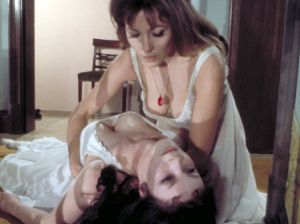 Ingrid Pitt as Carmilla in THE VAMPIRE LOVERS (1970). Looking to inject new blood in the vampire formula, Hammer Films (the company behind HORROR OF DRACULA) decided to make the eroticism even more overt in this adaptation of J. Sheridan LeFanus’ classic novella, Carmilla. Pitt plays the vampire countess not only as an insatiable seductress but also as a passionate lover: when necessary, she effortlessly uses her sex appeal to seduce those who might interfere with her plans, but she also truly wants her intended victim to follow her willingly into the netherworld of vampirism. Carmilla uses her body like a weapon to get what she wants, and Pitt dominates the screen in the role, practically burning up the screen.
Ingrid Pitt as Carmilla in THE VAMPIRE LOVERS (1970). Looking to inject new blood in the vampire formula, Hammer Films (the company behind HORROR OF DRACULA) decided to make the eroticism even more overt in this adaptation of J. Sheridan LeFanus’ classic novella, Carmilla. Pitt plays the vampire countess not only as an insatiable seductress but also as a passionate lover: when necessary, she effortlessly uses her sex appeal to seduce those who might interfere with her plans, but she also truly wants her intended victim to follow her willingly into the netherworld of vampirism. Carmilla uses her body like a weapon to get what she wants, and Pitt dominates the screen in the role, practically burning up the screen.
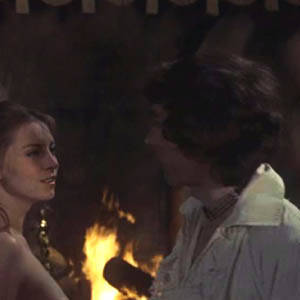 Robert Tayman as Count Mitterhaus in VAMPIRE CIRCUS (1972). Another vampire variant from Hammer films, this one portrays the undead as members of a circus that comes to town and seduces the local populace. It is all to avenge the death of Count Mitterhaus, who is dispatched in the pre-credits prologue after seducing a school master’s wife. Tayman gives a memorable, albeit truncated performance, as the Count, for whom various carnal appetites are barely distinguishable. “One lust feeds another,” he says, as he switches from blood-drinking to love-making, earning his place in cinema history as the first movie vampire who seems capable of having conventional sex.
Robert Tayman as Count Mitterhaus in VAMPIRE CIRCUS (1972). Another vampire variant from Hammer films, this one portrays the undead as members of a circus that comes to town and seduces the local populace. It is all to avenge the death of Count Mitterhaus, who is dispatched in the pre-credits prologue after seducing a school master’s wife. Tayman gives a memorable, albeit truncated performance, as the Count, for whom various carnal appetites are barely distinguishable. “One lust feeds another,” he says, as he switches from blood-drinking to love-making, earning his place in cinema history as the first movie vampire who seems capable of having conventional sex.
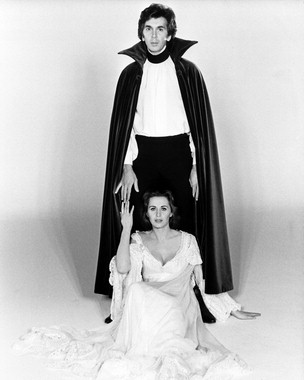 Frank Langella as Dracula in DRACULA (1979). As Dracula, Langella emphasizes the Count’s aristocratic manner and his romantic charm; he is also probably the first actor to make Dracula truly sympathetic. Like Lugosi, he’s the guy you just can’t compete with for the girl’s affections, because you know you are going to lose. The difference is that Langella’s vampire actually seems to admire Lucy (Kate Nelligan) for her strong-willed, independent ways: he’s not so much seducing her as courting her. The consummation, when it comes, is filmed with cloudy laser lights, suggesting a rapturous romantic interlude of mutual satisfaction. Unlike Mitterhaus in VAMPIRE CIRCUS, it is not clear that he has conventional sex, but the way the scene is presented visually, he might as well have. The result is not only sexy but also romantic, in a way that the later BRAM STOKER’S DRACULA could only hope to be.
Frank Langella as Dracula in DRACULA (1979). As Dracula, Langella emphasizes the Count’s aristocratic manner and his romantic charm; he is also probably the first actor to make Dracula truly sympathetic. Like Lugosi, he’s the guy you just can’t compete with for the girl’s affections, because you know you are going to lose. The difference is that Langella’s vampire actually seems to admire Lucy (Kate Nelligan) for her strong-willed, independent ways: he’s not so much seducing her as courting her. The consummation, when it comes, is filmed with cloudy laser lights, suggesting a rapturous romantic interlude of mutual satisfaction. Unlike Mitterhaus in VAMPIRE CIRCUS, it is not clear that he has conventional sex, but the way the scene is presented visually, he might as well have. The result is not only sexy but also romantic, in a way that the later BRAM STOKER’S DRACULA could only hope to be.
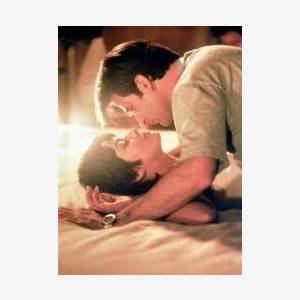 Anne Parillaud as Marie in INNOCENT BLOOD (1992). This disappointing horror-comedy from director John Landis features Parillaud (who came to fame as the original LE FEMME NIKITA) as a vampire who kills only murderers. She teams up with a cop (Anthony LaPaglia), and the two take on the Mob, but complications arise when one of her victims becomes a vampire and starts turning other criminals into vampires as well. The film’s main appeal is Parillaud, who makes for a slim and sexy vampire. The highligh is her bedroom seen with LaPaglia, whose cop is so frightened of her superhuman abilities that he can rise to the occasion only if she is in handcuffs (which she almost immediately breaks anyway). It’s like a fun, teasing variation on the whacked-out misogynistic paranoid of Paul Schrader’s CAT PEOPLE (1982), made by a director who doesn’t think women need to be locked up in cages to protect men from their predatory ways.
Anne Parillaud as Marie in INNOCENT BLOOD (1992). This disappointing horror-comedy from director John Landis features Parillaud (who came to fame as the original LE FEMME NIKITA) as a vampire who kills only murderers. She teams up with a cop (Anthony LaPaglia), and the two take on the Mob, but complications arise when one of her victims becomes a vampire and starts turning other criminals into vampires as well. The film’s main appeal is Parillaud, who makes for a slim and sexy vampire. The highligh is her bedroom seen with LaPaglia, whose cop is so frightened of her superhuman abilities that he can rise to the occasion only if she is in handcuffs (which she almost immediately breaks anyway). It’s like a fun, teasing variation on the whacked-out misogynistic paranoid of Paul Schrader’s CAT PEOPLE (1982), made by a director who doesn’t think women need to be locked up in cages to protect men from their predatory ways.
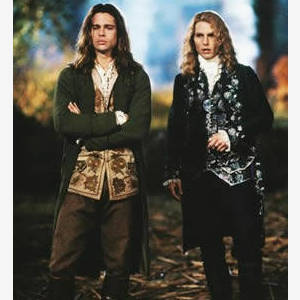 Brad Pitt and/or Tom Cruise in INTERVIEW WITH THE VAMPIRE (1994). Neil Jordan’s film comes nowhere near achieving the full brilliance of Anne Rice’s novel, but it does capture some of the essence, particularly the erotic though not necessarily sexual nature of vampires. In this telling, the undead’s sexual apetites have been completely subsumed into blood-drinking, which creates as much rapturous joy as any conventional orgasm. Pitt and Cruise make for a handsome pair of homo-erotic immortals, and the film works overtime to keep passions so high that the predatory nature of their characters never interferes with the female audience’s urge to swoon over their beauty.
Brad Pitt and/or Tom Cruise in INTERVIEW WITH THE VAMPIRE (1994). Neil Jordan’s film comes nowhere near achieving the full brilliance of Anne Rice’s novel, but it does capture some of the essence, particularly the erotic though not necessarily sexual nature of vampires. In this telling, the undead’s sexual apetites have been completely subsumed into blood-drinking, which creates as much rapturous joy as any conventional orgasm. Pitt and Cruise make for a handsome pair of homo-erotic immortals, and the film works overtime to keep passions so high that the predatory nature of their characters never interferes with the female audience’s urge to swoon over their beauty.
There have not been many memorably hot vampires since INTERVIEW. Series like BUFFY THE VAMPIRE SLAYER, ANGEL, and MOONLIGHT keep the tradition alive, but the emphasis is as much on angst as attraction – a trend brought to full fruition in TWILIGHT, where the whole point is the rapturous ecstasy of abstinence, lusting for a hot-blooded vampire who dare not draw too near, for fear that his bestial nature will take over. This modern approach to vampirism has its appeal, but it burns a few degress cooler than earlier generations of vampires, for whom blood-drinking was an all-purpose symbol for breaking taboos. Elicit pleasures burns much hotter when they are forbidden by feelings of guilt and sin. Edward Cullen’s self-restraint may be admirable, but for searing passionate can it really match the erotic allure of succumbing to the temptation of a demon lover who is truly demonic?
